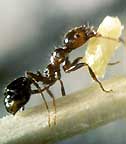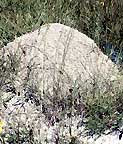However, in recent years Southwest Missouri has had to import hay, much of it from parts of the southern US also considered the "Fire Ant Belt." How does this change the potential risk, you ask?
Fire ants, that have infested more han 380 million acres in at least 13 states, according to the USDA's Animal and Plant Health Inspection Service (APHIS), have been known to hitch a ride in a bale of hay. They go wherever the hay goes.
Besides in other southern states APHIS is enforcing a federal quarantine regulating the transport of baled hay in direct contact with the ground, soil, grass sod and soil-moving equipment in large portions of the neighboring state of Arkansas that has been infested.


This imported fire ant looks innocent enough, at left, but don't make the mistake of stepping on his nest, a mount that may be as high as two feet tall, pictured right. He and his buddies, upwards of 250,000 in the colony, won't let you forget it. These mounds are especially dangerous to young children and pets. (Photos courtesy of USDA APHIS PPQ, Bugwood.org).
Native to South America, the ants were inadvertently introduced to the US about 100 years ago. They came, apparently their natural predators did not.
Imported fire ants are considered a minor threat to agricultural crops and a bigger threat to the landscaping, nursery and sod industries, according to Extension entomologist Richard Houseman. They have a major impact in residential areas," Houseman said. "They produce unsightly mounds, enter residential structures and deliver a potent sting when they are threatened or disturbed."
The ants are described by APHIS as being reddish-brown or black, 1/8 to 1/4-inch long, and, perhaps, not distinguishable from other ants, except for their behavior. When they attack en masse, the ants repeatedly stab their victims with venom-filled stingers that causes an acute burning sensation followed by the formation of painful or itchy white pustules that linger before healing.
To report sighting an ant colony in the Southwest Missouri area contact the Southwest Regional office, MU Extension at (417) 865-0707 or send an e-mail here. Contact information for other Extension offices may be found here.






Comments